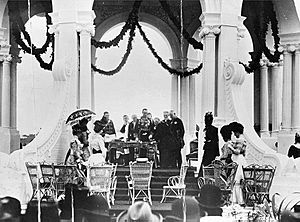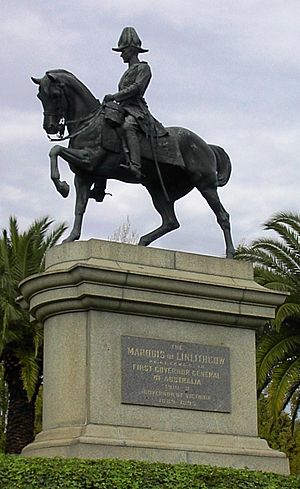John Hope, 7th Earl of Hopetoun facts for kids
Quick facts for kids
The Most Honourable
The Marquess of Linlithgow
|
|
|---|---|

Hope in 1902
|
|
| 1st Governor-General of Australia | |
| In office 1 January 1901 – 17 July 1902 |
|
| Monarch | Victoria Edward VII |
| Prime Minister | Edmund Barton |
| Preceded by | New position |
| Succeeded by | Lord Tennyson |
| 7th Governor of Victoria | |
| In office 28 November 1889 – 12 July 1895 |
|
| Premier | Duncan Gillies James Munro William Shiels James Patterson George Turner |
| Preceded by | Lord Loch |
| Succeeded by | Lord Brassey |
| Secretary for Scotland | |
| In office 2 February 1905 – 4 December 1905 |
|
| Prime Minister | Arthur Balfour |
| Preceded by | Andrew Murray |
| Succeeded by | John Sinclair |
| Personal details | |
| Born | Victoria]] 25 September 1860 South Queensferry, West Lothian, Scotland |
| Died | 29 February 1908 (aged 47) Pau, France |
| Resting place | Victoria]] |
| Political party | Conservative |
| Spouse |
Hon. Hersey Eveleigh-de Moleyns
(m. 1886) |
| Children |
|
| Parents |
|
| Alma mater | |
| Occupation | Statesman, aristocrat |
John Adrian Louis Hope, 1st Marquess of Linlithgow, also known as the 7th Earl of Hopetoun, was a British nobleman and politician. He was born on September 25, 1860, and passed away on February 29, 1908. He is best known for being the very first Governor-General of Australia. He held this important role from 1901 to 1902. Before that, he was the Governor of Victoria from 1889 to 1895.
Lord Hopetoun came from a noble Scottish family. He became the Earl of Hopetoun when he was just 12 years old, after his father passed away. He went to famous schools like Eton College and the Royal Military Academy Sandhurst. Even though he trained in the military, he decided not to become a full-time soldier. Instead, he focused on managing his family's large estates. He was a member of the Conservative Party in the House of Lords, which is part of the British Parliament.
Contents
Early Life and Political Start
John Hope was born in South Queensferry, Scotland. He was the oldest son of the 6th Earl of Hopetoun. After finishing his education, he decided to manage his family's huge land, which was over 17,000 hectares (about 42,500 acres).
In 1886, he married Hersey Alice Eveleigh-de Moleyns in London. She was also from a noble family. They had two sons and one daughter. Their oldest son, Victor, later became the Governor-General of India.
Lord Hopetoun began his political career in 1883. He worked as a whip for the Conservative Party in the House of Lords. He also served as a Lord-in-waiting to Queen Victoria from 1885 to 1889. This meant he was an attendant to the Queen. From 1887 to 1889, he was also the Lord High Commissioner to the General Assembly of the Church of Scotland.
Governor of Victoria
In 1889, at the age of 29, Lord Hopetoun was chosen to be the Governor of Victoria, a colony in Australia. He served in this role until 1895. At this time, British governors were starting to show more pride in the Empire. They were often young, wealthy noblemen.
Lord Hopetoun was known for his grand parties and events. Even though he had some health issues, people liked his energy and how he explored the colony on horseback. His time as Governor happened during a difficult period for the Australian colonies. There was an economic crash in 1891, which led to a long period of financial problems and political changes.
Despite these challenges, Lord Hopetoun managed well and stayed in office longer than most governors. By this time, governors had less direct power. Their role was more about representing the Queen and being a symbol.
Lord Hopetoun was a strong supporter of the idea of federation. This was the movement to unite the separate Australian colonies into one country. He gave many speeches supporting this idea. He even said he would come back to Australia as the first Governor-General if federation happened. When he left Victoria in 1895, he was very popular.
Australia's First Governor-General
After returning to the United Kingdom, Lord Hopetoun continued his political career. He served in the British government as Paymaster-General and then as Lord Chamberlain.
When the Australian colonies decided to unite and form the Commonwealth of Australia on January 1, 1901, Lord Hopetoun was a clear choice for the first Governor-General of Australia. He was popular in Australia and knew many Australian politicians. The British government believed he was very qualified for this important job.
Lord Hopetoun arrived in Sydney on December 15, 1900. He had traveled through India, where he caught typhoid fever. His wife also got malaria. This made his health worse, and the long journey was very difficult.
The "Hopetoun Blunder"
One of Lord Hopetoun's first big tasks was to choose a prime minister for the new country. The first federal election was not until March 1901. So, he couldn't just pick the leader of the winning party.
On December 19, 1900, Lord Hopetoun asked Sir William Lyne, the Premier of New South Wales, to form the first government. This surprised many people. Most Australians thought Edmund Barton, a key leader of the federation movement, should be the first prime minister. Lyne had actually been against federation until recently, and many federalist politicians did not support him.
It quickly became clear that Lyne could not form a government. Other important politicians, like Alfred Deakin, refused to work under him. So, Lyne gave up the task. On December 24, Lord Hopetoun then asked Edmund Barton to be prime minister. Barton successfully formed a government, which included Lyne. This new government was sworn in on New Year's Day, 1901, when Australia officially became a nation.
Lord Hopetoun tried to follow existing rules from Canada and Britain for his duties. He wanted to set good examples for the new nation. He had a good relationship with Prime Minister Barton and consulted with him often.
Challenges and Public Opinion
More challenges came up as the new government was set up. Lord Hopetoun brought his own private secretary, Captain Edward Wallington, from Britain. Australians didn't like that an Englishman was in charge of official communications. Wallington was not accountable to the Australian Parliament, even though he had an important role.
There were also disagreements between Lord Hopetoun and the governors of the individual states. They argued about who had the right to see official messages. These issues were eventually sorted out, but they showed the early struggles of the new federal system. Lord Hopetoun worked to unite the states and make people trust the new national government. He also hosted a Royal Visit in 1901, which helped make his position more secure.
People also complained about Lord Hopetoun's very grand style and the high costs involved. His official visits to the states were expensive. These costs were not always paid back by the Commonwealth government. This caused problems between the states and the federal government.
Lord Hopetoun also made some public comments about political matters. In January 1902, he spoke about Australia's support for the Second Boer War. He defended the government's decision to send troops. Opposition leader George Reid criticized this, saying the Governor-General should not interfere in political debates. This led to important discussions about the role of the Governor-General.
Lord Hopetoun also influenced the Immigration Restriction Act 1901. The British government did not like the original version of this law. Lord Hopetoun had to work carefully to get changes made. He used his power to delay the law until the Australian government made some changes. This showed his skill in handling difficult situations without causing public conflict.
An interesting friendship grew between Lord Hopetoun and a Melbourne union leader named Chummy Fleming. In 1901, Fleming stopped the Governor-General's carriage to protest unemployment. Lord Hopetoun listened to him and later helped speed up government work projects.
Financial Problems and Resignation
Lord Hopetoun's time as Governor-General ended suddenly because of a disagreement about money. His salary was set at a generous £10,000. However, there were no clear rules for his travel, housing, and entertainment expenses.
Both New South Wales and Victoria wanted the Governor-General to live in their capital cities. So, houses were provided in both states. But the cost of keeping up two large homes, plus planning for a third in the future capital, became a big problem. The states did not want to pay for these expenses.
Lord Hopetoun had not received a formal allowance for his expenses. He was told privately by Prime Minister Barton that he would have at least £8,000 a year. Lord Hopetoun was naturally a very grand person and spent a lot of his own money on official duties and the Royal Visit. This put a strain on his personal finances.
When a bill was finally brought to Parliament in mid-1902 to cover these costs, it was rejected. Parliament made it clear that no extra money would be approved beyond his salary. Lord Hopetoun was very upset. He had already spent a lot of his own money.
Feeling embarrassed and still unwell, Lord Hopetoun asked to be recalled from his position on May 5, 1902. The British government agreed.
People disagreed about who was to blame for his sudden resignation. Many tried to convince him to stay. But it became clear that Lord Hopetoun's idea of the Governor-General's role was too grand for Australia. He saw it as a very elaborate position, like the Viceroy of India. This did not match what Australians expected.
Lord Hopetoun and his family left Australia on July 17, 1902. He was still very popular with the public, and there were emotional farewell ceremonies. When he returned to Britain, King Edward VII gave him the title Marquess of Linlithgow. However, many felt that his time as Governor-General had not been a success.
Later Life
Lord Linlithgow wanted to become the Viceroy of India, but his poor health prevented it. However, his son Victor later held that important role from 1936 to 1943.
His last political job was as Secretary of State for Scotland in 1905. His health continued to be poor. He passed away suddenly in Pau, France, on February 29, 1908, at the age of 47.
Images for kids






